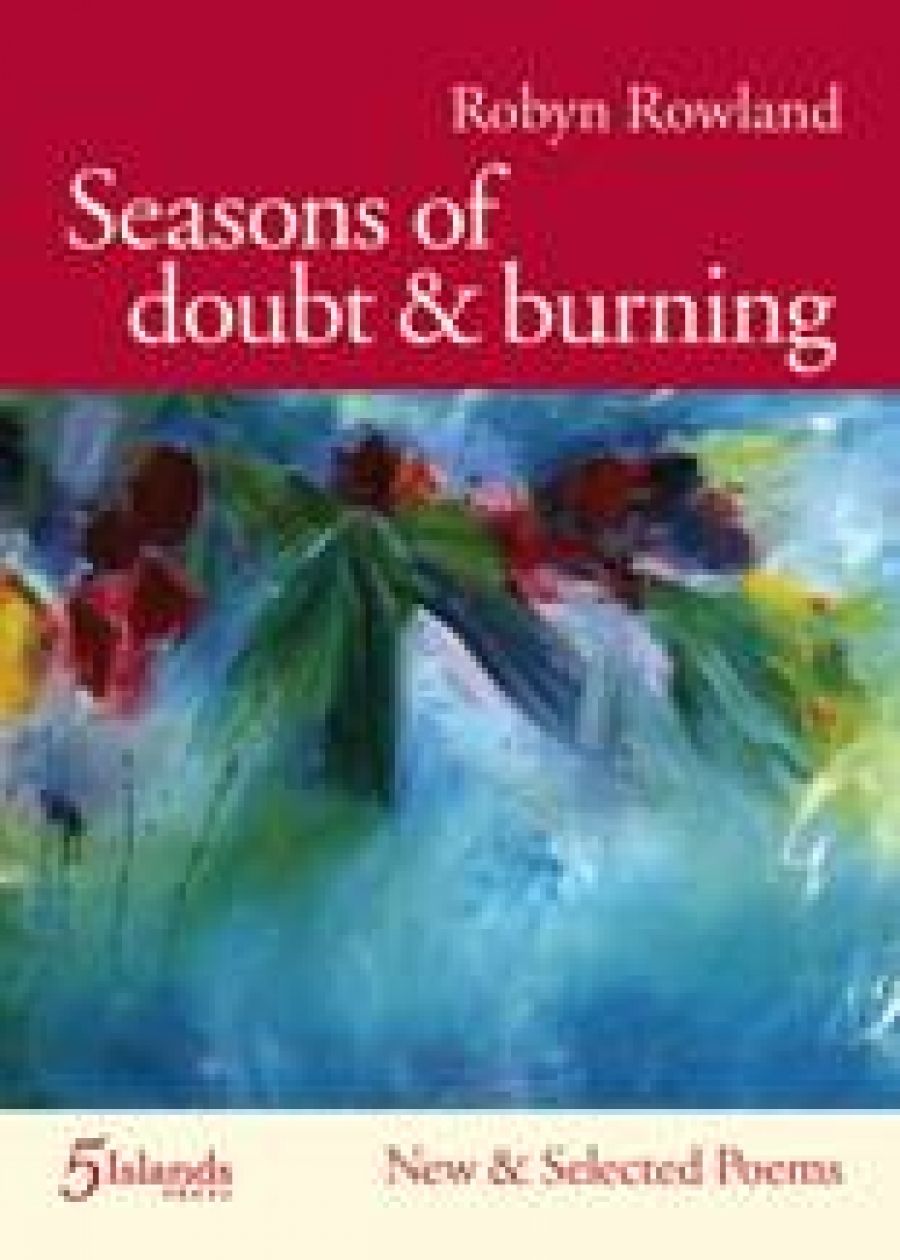
- Free Article: No
- Contents Category: Poetry
- Review Article: Yes
- Article Title: ‘Hope in flight’
- Online Only: No
- Custom Highlight Text:
Robyn Rowland writes what could be described as a traditionally feminine, aestheticised mode of lyric poetry. Rowland’s poetic landscape is one that shimmers with moonlight, in which one finds cherry blossom and exotic fruit, waterfalls and peacocks, and sensuality (if not sex), and in which the language is always pleasing. Perhaps it is my cultural background – coming from a dour nation of Finns – or the fact that I am a formworker’s daughter, but this world is not familiar to me. Indeed, it seems to belong to a particular tradition of lyric poetry, rather than to any reality. Nevertheless, there is honesty and poignancy in Rowland’s New and Selected Poems, which speak of lost relationships, childbirth, illness, the death of loved ones, and the various individuals and historical events that inspired her interest or hope.
- Book 1 Title: Seasons of doubt & burning
- Book 1 Subtitle: New and selected poems
- Book 1 Biblio: Five Islands Press, $29.95 pb, 226 pp
The collection begins with Rowland’s new poems, many of which focus on the sea. The first poem, ‘Perishing’, a Yeatsian contemplation of the apocalyptic threat of global warming to ice shelves, begins in a typically aestheticised and exoticised vein: ‘Through skins of white-green ice / their blue hearts throb / more light-filled than sapphires or / the slick glaze of an Egyptian bowl.’ Another poem, ‘The Free Air’, romanticises the experience of Eva Carmichael, a survivor of the 1878 Loch Ard shipwreck: ‘Lifted for a moment, and the dark sky a shawl, / her night-dress fluttering as she flies, / an angel she could be, or hope in flight.’ The poems from the sequence called ‘Literary Creatures’, which are my favourites, depict the primeval and uncanny lives of cuttlefish, horseshoe crabs, and seahorses in intimate detail. ‘A Colony of Xiphosura – Horseshoe Crab’ ends: ‘thriving before dinosaurs / before flowering plants, / you need nothing from us, / your jangle of parts in perfect symmetry for survival, / making a good luck charm out of living.’
A clear interest of Rowland’s, consistent with traditional lyric verse, is the ways in which poetry can engage with landscape. We see this acknowledged in ‘Is the Light Right?’ in which the poet, driving home through a dramatic landscape, refers to ‘the spirit of poetry / rising in me like a prayer’. The personal is another feature of Rowland’s poetry, with the autobiographical consistently sitting alongside an interest in the historical and landscape. ‘What We Made’, for instance, reflects on the relationship between the ageing poet and her elderly father: ‘Look at us – really Dad – each likely to stumble now, / each with our hand already cupping the elbow beside, / faces glistening with the salt that wind and waves / might bury us with, or wear us away.’
The Selected Poems begin with work from Rowland’s first collection, Filigree in Blood (1982). These earlier poems are plainer, but they reveal the poet’s abiding interest in the personal as well as in the historical and landscape – although drier Australian scenery is featured here. In terms of the personal, ‘Construction’, another poem about the poet’s father, provides a nice companion piece to ‘What We Made’. Historical interests are represented by ‘Ballad for Jimmie Governor’ and ‘Lament for Ethel Governor’, poems based on the tragic story of a couple vilified for their interracial marriage. In 1900, Jimmie Governor, as the fascinating note to the first poem tells us, murdered nine people with an axe – an event made famous by the novel (and film) The Chant of Jimmie Blacksmith.
The poems from Perverse Serenity (1990), as a note to the selection reveals, trace ‘the end of a relationship between a man and a woman in Australia and a love between that woman and a man in Ireland’. Rowland’s poetry, from this point on, often explores her relationship with the landscapes of Ireland, with the biographical note to the book explaining that she is third-generation Irish-Australian. Fiery Waters (2001), the collection represented next, returns to Rowland’s interests in the historical and the personal, with poems about the Stolen Generations and the poet’s near-death experience in giving birth to her son.
The final two represented collections, Shadows at the Gate (2004) and Silence and its Tongues (2006), are stronger for a focus on corporeality and mortality. The poems from ‘Dead Mother Poems’ are worth noting as powerful reflections on the death of the poet’s mother. ‘Boned’, a poem about osteoporosis, is also very effective. The poet reflects: ‘I didn’t know to be aware. / I thought bone hard; permanent.’ Bog People, Pharaohs, dinosaurs ‘and all the no-names of the earth, / leave their skeletons as proof of their life’. There is also the disarmingly honest and affecting ‘The Caught Tide’, in which the poet, in the aftermath of failed relationships, reflects on loneliness, ‘Unsure whether this scarcity marks / another brief sigh / or the final long lament’.
Regardless of my difficulties with Rowland’s aesthetic, on finishing her New and Selected Poems I ultimately felt moved by poetry’s testimonial powers – undoubtedly pronounced as a result of the Selected format, which provides such a clear overview of the poet’s career and life. I experienced a sense of honour in being allowed to observe the poet’s work and life, and wondered whether the profoundest value of poetry might be in the vulnerable experience of living that it articulates.


Comments powered by CComment